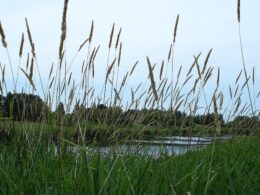What Is Kentucky Blue Grass?
Kentucky Blue Grass (Poa Patensis) is also known as Kentucky Bluegrass and Common Meadow Grass. It is in the family of Gramineae, or grasses, and grows best in cool, moist climates. Kentucky blue grass is a perennial grass that is a cool-season species.
Kentucky Blue Grass Appearance
Kentucky Blue Grass is a very common sod-forming grass. It has short rhizomes that can spread rapidly via cells at the tips of the rhizomes that form new plants. Kentucky Blue Grass has flat, V-shaped leaves and grows in dense tufts. The plants can grow to 12-28 inches tall, but have slender stems. The leaves are flat with smooth edges, and are 10–20 cm long and 3-5 mm wide. The inflorescence is an open panicle up to 15 cm long with a variable number of spikelets.
Kentucky Blue Grass Habitat and Distribution
The native range of Kentucky bluegrass is Europe, Asia, and northern Africa. It has also become naturalized in other parts of the world, including North America. It grows in open fields, meadows, and pastures. It is also commonly planted as a lawn grass.
Kentucky Bluegrass Lawn Care
A good growing environment is essential for Kentucky bluegrass to thrive. To help ensure that your lawn stays lush and green, keep the following tips in mind.
Mowing
Blue grass should be mowed twice a year: once in the spring and once in the late summer or early fall. It’s also important to make sure you’re mowing at the proper height. The cut should be between 2.5 and 3 inches tall. When this type of grass is kept at its ideal length, it will stay healthy and continue enriching your landscape.
Watering
You can water your Kentucky Blue Grass lawn as often as it needs to be—this is an easy way to judge how much water it needs. To determine how often you should water your bluegrass, consider the soil type, whether you’ve got any slopes or hills, and what kind of weather you’re having. In hot, dry weather, the grass will need more water than in cooler temperatures with regular rainfall. A rain gauge can be a helpful tool. If there’s not been at least 1 inch of rain in a week, then your lawn needs watering. The grass will turn brown after 7 days of not watering it.
Kentucky Blue Grass Growing Conditions
Kentucky Blue Grass is a cool-season perennial grass and is the most commonly used turf grass. Take a look at what it needs:
Light
Kentucky bluegrass seeds are a cool-season grass, but they thrive in full sun for optimum development. Bluegrass seed lawns may nevertheless flourish in partial shade.
The Best Time to Plant Kentucky Blue Grass
Fall is the perfect time to plant Kentucky Blue Grass (Poa pratensis). It’s a time when the soil is warm, but the air temperature isn’t too hot. The grass will have time to become established before winter sets in and before the scorching heat of summer.
Planting Kentucky Blue Grass
To be productive, however, you’ll first want to prepare the area where you’ll be planting your grass. If it’s a new area, clear away any debris or other plants that are currently occupying the space. Then inspect the soil and make sure that it’s loose enough for roots to penetrate easily and that there are no rocks or other obstructions; if necessary, you can use a tiller to churn up compacted soil before you plant your grass. You may also want to consider applying fertilizer or other nutrients at this time.
Temperature
The best temperature for planting Kentucky Blue Grass is between 55 °F and 75 °F. If the ambient temperature is above or below this range, your germination rate will decrease.
Soil
When you’re planning on planting Kentucky Blue Grass, it’s a good idea to check the pH of your soil. If it’s too acidic (anything below 5.5) or too alkaline (above 8.0), it’s time to treat the ground before you plant. The best soil for Kentucky Blue Grass is neutral, with a pH of 6.0 to 7.0.
Use of Poa Pratensis
Kentucky bluegrass is a perennial grass that is used for lawns, pastures, and hay. It is also useful for erosion control on bank stabilization projects and on highway slopes. The grass spreads both by seed and by underground stems called rhizomes. The seedlings are slow to establish, but the mature sod is dense and resilient. It has good wear tolerance and a deep green color.
Kentucky Blue Grass as Weed
In Canada, Kentucky bluegrass is considered an indicator species of disturbed and degraded landscape. It thrives in heavy, wet soil and can tolerate repeated grazing. This plant is a good choice for high traffic areas, due to its high drought tolerance, but it is not recommended for sodding or overseeding in the south because it can go dormant and turn brown.
Common Problems With Kentucky Blue Grass
There are several species of fungi that cause Kentucky Blue Grass to become infected with mold. Common problems include rust, leaf spot and dollar spot.
Symptoms of an Unhealthy Lawn
Rust appears as reddish-orange spots on the leaves and stems of the grass. Leaf spot is another common affliction: its symptoms include brownish-gray spots with purple borders on the leaves. Dollar spot appears as patches on the leaves; you may also notice straw color or dead areas in these spots. If you’ve been over-watering your lawn, these are just some consequences you might have to deal with.
Maintaining a Healthy Lawn
Make sure that you’re not over-watering (which can cause root rot), but also not under-watering (which leads to drought stress). If you’re still having trouble keeping your lawn green and full despite your best efforts at watering, try applying a fungicide or insecticide to help treat any diseases or pests that might be affecting the health of your Kentucky blue grass.



















